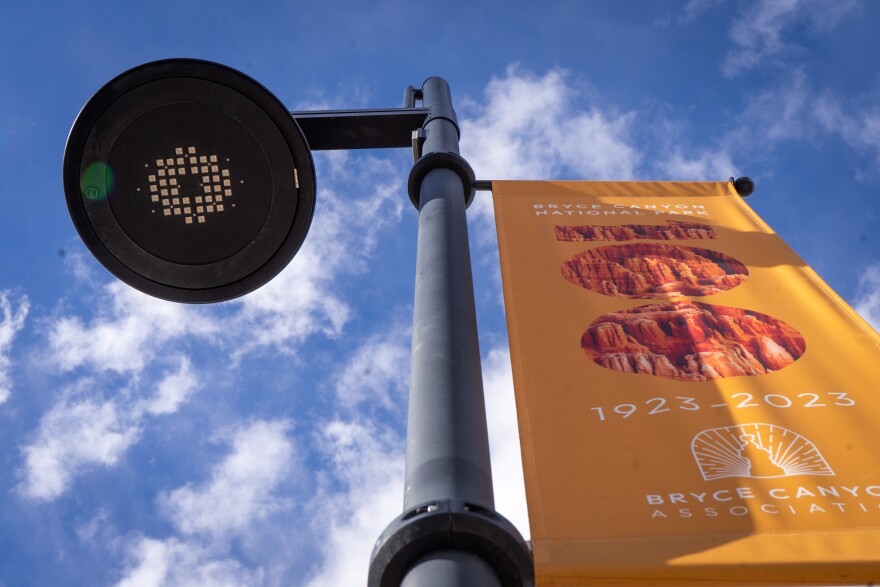The wildly popular Bryce Canyon National Park turns 100 years old on June 8.
As more and more people come to visit the centenarian, park officials have to balance welcoming the public with preserving the land. That can be tricky because those two things are often at odds.
People come from all over the world to see the towering orange rock formations known as hoodoos. Kelly Wood, the outdoor recreation planner for Bryce Canyon, said it’s really special to watch someone experience the park for the first time.
“It's the same feeling you get when you find out your friend hasn't seen your favorite movie and you get to share it with them,” she said. “I love getting to experience that moment.”

And a lot of people are having that moment — the park got 2.35 million visitors last year. That’s a lot of warm bodies inside 56.2 square miles.
Bryce Canyon Superintendent Jim Ireland said the park — one of the smallest in the country — is at the edge of what staff can manage with the current visitorship.
“We don't have unlimited resources, fiscal resources, human resources,” he said.
There aren’t enough parking spaces, and a few times a year, the park gets so full that they have to restrict entry for a few hours. And more and more people threaten the dark skies, quiet lands and clear air the park prides itself on.
Relationships with local towns and Native American tribes
Looking out past the hoodoos, there are deep purples, blues and browns for miles around. But most of that isn’t actually in park boundaries. So officials team up with people who are also deeply invested in the park’s future, including local towns like Bryce Canyon City.
Mayor Shiloh Syrett is one of 200 year-round residents. He said without the park, the town wouldn’t exist.
“We all rely on tourism. And so anything we can to bring more people here and make sure they enjoy these kinds of things, yeah.”
But as more people come and pollute the area, the attraction of the park could fade. So the city spent an extra $120,000 when they installed street lights to help protect the night sky.
“It's directed right at the road. So it doesn't allow the light to go up into the sky. Just a low white color,” Syrett said.

When Syrett isn’t acting as the mayor, he manages the ATV tours for Ruby’s Inn. They only take six ATVs out at a time and go slow to reduce noise pollution.
“There's a difference between going 10 miles an hour versus just constant throttle on and off and revving them up,” Syrett said. “So we make sure that we're not allowing those kinds of things.”
And the town lets the park use land and buildings for the privately-run shuttle system.

Ireland, Bryce’s superintendent, is working to get more people to ride the shuttle or bike into the park. He hopes to add another 2 miles to the bike trail in the next year or so.
The park is also working with Native American tribes with cultural ties to the land and is hiring its first two tribal interns.
“Recently, we had a group of Paiute elders into the park to talk to us and build those personal relationships,” Ireland said.
Daniel Bullets of the Kaibab Band of Paiute Indians said his tribe had to fight for a seat at the table in the past. But now, they have a good relationship with the park, and he hopes that continues.
“Communication is key to everything,” he said. “We want people that are there to learn from us.”
Educating the public
Wood, the outdoor recreation planner, is also working on building a relationship with the public.
“Much of the visitor congestion challenges are things that we can educate visitors to be able to plan for.”

For example, letting people know that 10 a.m. to 4 p.m. is the busiest time at the park.
“We're also collecting data on resource impacts,” Wood said. “As folks are cutting switchbacks or trampling plants, looking at trends over time.”
Ireland said that right now, there aren’t plans to do a timed entry or reservation system, but it’s not off the table.
For the centennial, there are billboards along I-15 advertising the park’s birthday and inviting people to come celebrate — which seems ironic.
“That's not lost on me,” Ireland acknowledged. “And that's the challenge for the Park Service, is that the people will come and we will work to accommodate them and manage the way we do every day, every summer, whether it's the centennial or not.”
But Ireland said he will always choose the health of the land over visitor access.
“If we don't protect the resource, there's nothing here for people to enjoy. So we will always err on the side of protection and preservation.”
He hopes he never has to make that choice.
This is one story in a two-part series on Bryce Canyon National Park’s centennial. Read here how the geology of the park could change into the next 100 years.






